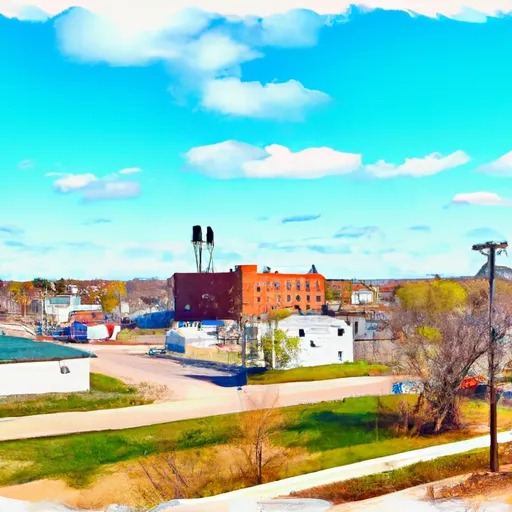-
 Snoflo Premium
Snoflo Premium
Get unlimited access to all our content
With no Ad interruptions! - Start Your Free Trial Login with existing account
Wilder
Eden Index
Climate
6.5
•
Recreation
1.7
•
Community
2.7
•
Safeguard
3.9/10

Wilder, Minnesota is a small town located in Nobles County in the southwestern corner of the state. The climate in Wilder is classified as continental, characterized by hot summers and cold winters. Summers are generally warm and humid, with temperatures reaching into the 80s°F (26-32°C), while winters are cold with temperatures dropping below freezing, often accompanied by snowfall.
The hydrology constituents in Wilder are shaped by the nearby Kanaranzi Creek, a small tributary of Rock River. This waterway provides opportunities for various outdoor activities such as fishing, canoeing, and kayaking. The creek is home to a variety of fish species, including bass and panfish, making it a popular spot for anglers.
In addition to water-based activities, Wilder offers various outdoor recreation opportunities on its surrounding land. The town is surrounded by picturesque prairies and farmlands, providing ample space for hiking, biking, and wildlife observation. Hunters can explore the nearby wildlife management areas, which offer opportunities for deer, pheasant, and waterfowl hunting during their respective seasons.
Overall, Wilder, Minnesota offers a diverse range of outdoor activities, making it an attractive destination for nature enthusiasts.
What is the Eden Index?
The Snoflo Eden Index serves as a comprehensive rating system for regions, evaluating their desirability through a holistic assessment of climate health, outdoor recreation opportunities, and natural disaster risk, acknowledging the profound impact of these factors on livability and well-being.
Climate Health Indicator (CHI): 6.5
Wilder receives approximately
758mm of rain per year,
with humidity levels near 81%
and air temperatures averaging around
8°C.
Wilder has a plant hardyness factor of
4, meaning
plants and agriculture in this region thrive during a short period during spring and early summer. Most
plants will die off during the colder winter months.
By considering the ideal temperature range, reliable water supplies, clean air, and stable seasonal rain or snowpacks, the Climate Health Indicator (CHI) underscores the significance of a healthy climate as the foundation for quality living.
A healthy climate is paramount for ensuring a high quality of life and livability in a region, fostering both physical well-being and environmental harmony. This can be characterized by ideal temperatures, reliable access to water supplies, clean air, and consistent seasonal rain or snowpacks.
Weather Forecast
Streamflow Conditions
Des Moines
Area Rivers
Des Moines
Snowpack Depths
Des Moines
Reservoir Storage Capacity
Des Moines
Groundwater Levels
Recreational Opportunity Index (ROI): 1.7
The Recreational Opportunity Index (ROI) recognizes the value of outdoor recreational options, such as parks, hiking trails, camping sites, and fishing spots, while acknowledging that climate plays a pivotal role in ensuring the comfort and consistency of these experiences.
Access to outdoor recreational opportunities, encompassing activities such as parks, hiking, camping, and fishing, is crucial for overall well-being, and the climate plays a pivotal role in enabling and enhancing these experiences, ensuring that individuals can engage in nature-based activities comfortably and consistently.
Camping Areas
| Campground | Campsites | Reservations | Toilets | Showers | Elevation |
|---|---|---|---|---|---|
| Prairie Rose State Park | 95 | 1,250 ft | |||
| Bertha City Park | None | 1,400 ft | |||
| Gilfillan Estate | 44 | 1,040 ft | |||
| Birch Coulee Co Park | None | 1,024 ft | |||
| Sailors and Soldiers Memorial Park | 24 | 1,035 ft | |||
| Rothenburg City Park | None | 1,015 ft | |||
| Alexander Ramsey Park | 31 | 1,019 ft | |||
| Pottawattamie County Fairgrounds | 60 | 1,132 ft | |||
| Nishna Bend Rec Area | 14 | 1,188 ft | |||
| Beaver Falls Co Park | None | 869 ft |
Nearby Fishing
Catastrophe Safeguard Index (CSI):
The Catastrophe Safeguard Index (CSI) recognizes that natural disaster risk, encompassing floods, fires, hurricanes, and tornadoes, can drastically affect safety and the overall appeal of an area.
The level of natural disaster risk in a region significantly affects safety and the overall livability, with climate change amplifying these risks by potentially increasing the frequency and intensity of events like floods, fires, hurricanes, and tornadoes, thereby posing substantial challenges to community resilience and well-being.
Community Resilience Indicator (CRI): 2.7
The Community Resilience Indicator (CRI) recognizes that education, healthcare, and socioeconomics are crucial to the well-being of a region. The CRI acknowledges the profound impact of these elements on residents' overall quality of life. By evaluating educational resources, healthcare accessibility, and economic inclusivity, the index captures the essential aspects that contribute to a thriving community, fostering resident satisfaction, equity, and social cohesion.

